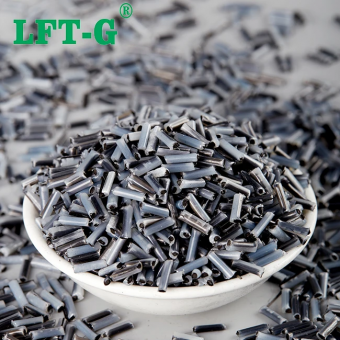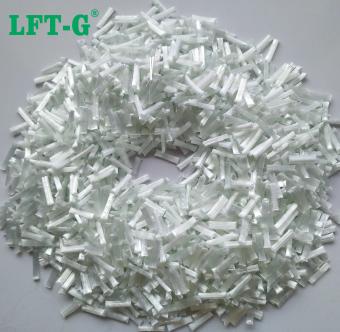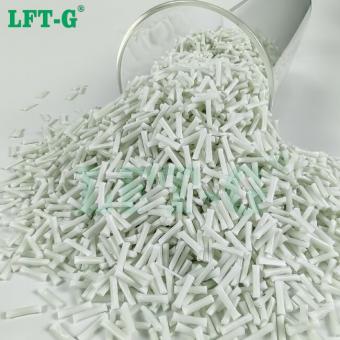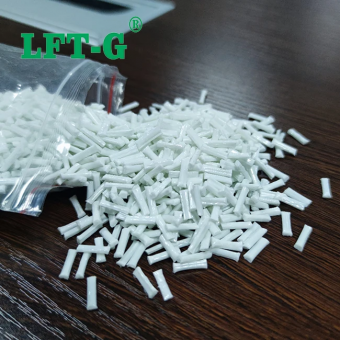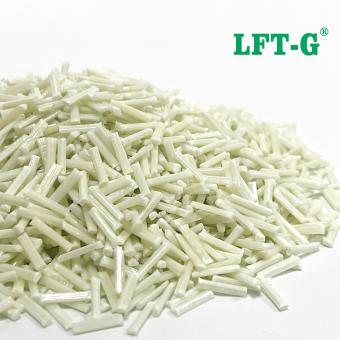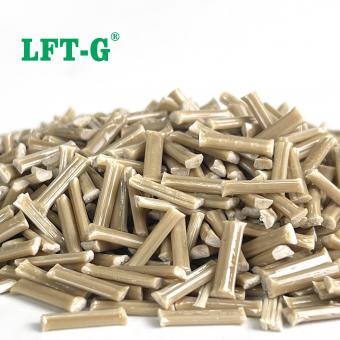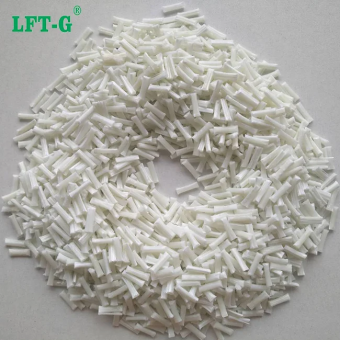Long carbon fiber is a new material with high strength and high modulus and excellent mechanical properties. It is a microcrystalline graphite material obtained by carbonization and graphitization of organic fibers. Its specific gravity is less than 1/4 of steel, and its strength is higher than that of steel. Corrosion resistant, high modulus, no melting. And a variety of resin substrates after impregnation extrusion molding into pellets, long carbon fiber polymer. Can be used for direct molding products. In recent years, it has been widely used in aerospace, mechanical and electronic chemicals.
-
LFT-G hot sell PEEK self own factory good price Long carbon fiber compounds reinforced plastic sample availavlePEEK PEEK, commonly referred to as polyetheretherketone, is part of the polyetherketone family of semi-crystalline thermoplastics. However, the unique 2:1 ether (E) to ketone (K) ratio of PEEK polymers provides superior chemical resistance compared to other polyetherketones and is a major factor in the wider use of PEEK, which is not only available as a pure resin, but can also be modified by the addition of carbon fiberfill. Its properties PEEK-LCF PEEK-LCF30% with 30% long carbon fiber filler has been our mainstay, and LFT-G's PEEK LCF30% is formulated with 30% long carbon fiber reinforcement to achieve the highest mechanical strength and stiffness of any PEEK grade. And PEEK LCF30% is unaffected by repeated autoclave cycles and is resistant to a wide range of chemicals. It also meets FDA requirements for direct food contact applications and meets the aerospace industry's stringent flammability and low smoke requirements with a flame retardancy rating of UL 94 V-0. It has the wear and temperature resistance of PEEK and can withstand long-term exposure to steam, hot water and a wide range of chemicals. In particular, it performs well as a bearing material when operating on hard mating surfaces, and its materials are often used in precision machined parts. It has the highest strength and stiffness of any PEEK grade. Although it contains more reinforcement per unit volume, it is 7% lighter than glass-reinforced grades. It is an excellent choice for high-load machined or molded parts. TDS for your reference Appilcation Details Number Colour Length Sample Package MOQ Delivery time Port of Loading PEEK-NA-LCF30 Natural colour (can be customized) About 12mm (can be customized) Available 20kg/bag 20kg 7-15 days after shipment Xiamen Port Reasons for selection The above general-purpose grade PEEK-LCF is LFT-G's main product, LFT-G can also provide more custom modification services, we have also been committed to custom R & D production of special engineering plastics PEEK, PPS, PP, PA6, PA66, PA12, TPU, ABS, etc. 01 Factory direct sales, with high-tech factory Affordable price and high quality products. 02 Large amount of inventory, hundred tons of stock Adequate stock, quality and quantity assurance, on-time delivery, the company has its own warehouse, a full range of products. 03 Provide perfect supporting services for customers Zhenghao has a perfect pre-sales, sales and after-sales service system; the first time to solve the customer's concerns. Frequently asked questions Q. When using long carbon fiber engineering plastics, what is the solution to the lack of torque an insufficient injection pressure? A. You can change the injection molding machine to a larger size, or increase the molding temperature, increase the injection pressure. Q. The cost of long fiber products is higher. Does it has a high recycling value? A. The thermoplastic LFT long fiber material can be recycled and reused very well. Q. Using a long fiber reinforced thermoplastic material, will it block the die hole due to the long length of the fiber or not? A. When using long glass fiber or long carbon fiber, it is necessary to evaluate whether the product is suitable for LFT-G. If the product is too small or the dispensing is not suitable for long fiber materials. The long fiber itself has requirements for the mold nozzle.
- High strength modified material
- peek CF30
- carbon fibre reinforced peek lcf pellet
- reinforced peek plastic
- peek LCf30 plastic injection part
Tags :
-
LFT-G PPS Polyphenylene sulfide composite long carbon fiber thermoplastic resin original color 12mmPPS Special engineering plastics are engineering plastics with higher overall performance and long-term use temperature above 150℃, PPS is one of them. The carbon fiber reinforced special engineering composites formed by carbon fiber as the reinforcement and these special engineering plastics as the matrix have excellent mechanical properties, wear resistance and high temperature resistance, which can be used in aerospace, marine or medical fields, and in some aspects show more desirable application advantages than thermosetting resins or even metal materials. PPS-LCF Polyphenylene sulfide PPS resin strength and hardness are relatively high, good mechanical properties, adapt to a variety of molding and processing methods, you can achieve secondary precision molding, the dimensional stability of the product is better. Its moisture absorption rate of only 0.03%, low density, melt temperature Tm of 285 ℃, the glass transition temperature Tg of 90 ℃, thermal stability is very good, in the air state, to reach 430 ℃ -460 ℃ before decomposition, high flame retardant grade, 200 ℃ insoluble in most organic solvents, excellent electrical insulation. As a special engineering plastics, PPS advantages are outstanding, but defects also exist, for example, because of the large number of benzene ring to make its impact resistance and elongation is not good enough, but through the carbon fiber reinforced way, can further improve the performance of the material strength and thermal stability, so as to better show the value of the application of the material. Through the carbon fiber reinforced intervention, changing the original insulating properties of PPS into a conductive, anti-static properties, polyphenylene sulfide PPS toughness and strength can be substantially increased and improved, becoming one of the most commonly used composite materials in the aerospace field. It is used in aircraft landing gear, wings, hatches, fuel tank port covers, J-shaped nose cone, cabin interior trim and other components, not only to help increase the impact resistance, high temperature and corrosion resistance of these parts, more through the reduction in mass, to enhance the aircraft load efficiency and reduce fuel consumption. Compared with metal, this composite material has the advantages of low cost and easy processing, the cost can be reduced by 20-50 percent. High bonding must be maintained between the carbon fiber reinforcement and the PPS resin matrix. When the product is subjected to stress, this high bonding helps the interface to transfer the external load to the fibers effectively, which can effectively prevent cracks from debonding between the interfaces, in addition to enhancing the mechanical properties of the composite. To make the resin matrix and carbon fiber reinforcement between the formation of high bonding, we must make the molten state of PPS resin and carbon fiber reinforcement in full contact, full impregnation, so that the fiber body in the case of uniform dispersion to achieve good impregnation effect. Production process Application of PPS-LCF Xiamen LFT composite plastic Co., Ltd We will offer you: 1. LFT & LFRT material technical parameters and leading edge design 2. Mold front design and recommendations 3. Provide technical support such as injection molding and extrusion molding. About us
- PPS polyphenylent
- Low warpage electronic appliance
- pps lcf40 granules raw material
- PPS long carbon fiber extrusion
- pps LCf40 plastic injection part
- PPS polymer carbon fiber pellets
Tags :
-
lft-g PA66 nylon66 filling long carbon fiber 20%-60% modified plastic higher performance natural colorMaterial Introduction In 1935, Wallace Carothers, a scientific researcher at DuPont, and his team successfully synthesized PA66 by condensation of adipic acid and adipic diamine for the first time, and DuPont completed the commercial production of PA66 fiber in 1939. Starting in the 1950s, PA, including PA6 and PA66, was developed for the production of injection molded products to replace metal to meet the requirements of light weight and cost reduction of industrial products. At present, PA66 is the most used PA species other than PA6. PA66 Scientific name: Polyhexanediamide Abbreviation: PA66 Common name: Nylon 66 PA66 has many similarities with PA6. PA66 is also a transparent to milky white granule that can take on almost any color with the addition of a colorant (masterbatch) specific for polymers. Material properties Similar to the basic properties of PA6, PA66 also has low specific gravity, high tensile strength, wear resistance, good self-lubrication, and excellent impact toughness. In addition, because the number of hydrogen bonds in PA66 is more than in PA6, the intermolecular force of PA66 is stronger than the intermolecular force of PA6, which makes the internal structure of PA66 more compact than PA6, with better thermal properties, higher rigidity and toughness, better dimensional stability, lower water absorption, and more wear resistance. However, PA66 has a higher market price than PA6 and is not as easy to process and mold as PA6. Like PA6, PA66 can also add a certain percentage of glass fiber, carbon fiber, etc. to improve the performance and meet the application needs of different products. The following table is a PA66-LCF30 performance table produced by Xiamen LFT composite plastic company. Materials Application PA66 has higher hardness, mechanical strength, toughness, self-lubrication, friction resistance, heat resistance after the addition of carbon fiber, and is widely used in automotive parts, electrical and electronic, as well as mechanical and engineering parts and other fields. Automotive parts PA66's low specific gravity, high rigidity, strong toughness, heat resistance and gasoline resistance make it widely used in automotive modules, automotive structural parts, automotive interior and exterior parts, automotive transmission system and chassis shield, automotive fuel system, automotive ignition system, etc. The products involve automotive cable channel modules, structural parts of front-end components of automotive sunroof system, automotive rearview mirror bracket, automotive radiator, headlight support frame, door module, seat structural parts, seat shell and backrest, dashboard skeleton, air cooler fan, etc. Electrical and electronics PA66's good insulation, flame retardancy and corrosion resistance make it suitable for making various connectors, switches, sockets, terminal blocks, wire coverings, wire ties, insulating spacers, circuit breaker housings, transformer bobbins, retaining clips and motor parts after glass fiber reinforcement. Mechanical and engineering parts PA66's good rigidity, toughness, self-lubricating properties, heat and abrasion resistance make it suitable for manufacturing various nuts, screws, cable ties, worm gears, rotating wheels, gears, pump impellers, pulley sleeves, bushings, solenoid distribution valve seats, power tool housings, pipes, luggage racks, fan housings, appliance housings, door and window frames, cable drag chains and large machine tool baffles. Details Number Color Length Sample Package MOQ Delivery time Port of Loading PA66-NA-LCF30 Natural color (can be customized) 12mm about (can be customized) Available 20kg/bag 20kg 7-15 days after shipment Xiamen Port Other products you may wonder pa6-lcf pa12-lcf peek-lcf Frequently asked questions Q. How to choose the reinforcement method and length of the material when using long fiber reinforced thermoplastic material? A. The selection of materials depend on the requirements of the products. It is necessary to access how much the content is enhanced and how much length is more appropriate, which are depending on the performance requirements of the products. Q. Under what circumstances can long fiber replace short fiber? What are the common alternative materials? A. Traditional staple fiber materials can be replaced with long glass fiber and long carbon fiber LFT materials in the case of customers whose mechanical properties cannot be met or where higher metal substitutes are desired. For example, PP long glass fiber is often replacing nylon reinforced glass fiber, and nylon long glass fiber is replacing PPS series. Q. Are there any special proc...
- self owing pa66 pellets
- high strength and high toughness reinforced pa66 pellets
- reinforced polyamide66 lcf
- polyamide 66 engineering plastics lcf
- PA66 6 twin screw lcf pellets
- recycle thermoplastic pa66 long carbon fiber
Tags :
-
LFT-G Homo PP fill Long carbon fiber LGF 20-60 injection molding high toughness and strength 12mmWhat is the Homo PP? Homopolymerized PP plastics are made by polymerizing a single propylene monomer and do not contain ethylene monomer in the molecular chain. Homopolymerized polypropylene pp plastic has the advantage of better strength. Disadvantages are poor impact resistance (more brittle), poor toughness, poor dimensional stability, easy aging, and poor long-term heat stability performance. PP as a thermoplastic polymer began commercial production in 1957, is the first of the regulated stand-alone polymers. Its historical significance is further reflected in the fact that it has been the fastest growing major thermoplastic and has a very wide range of applications within the thermoplastic field, especially in fiber and filament, film extrusion, and injection molding processes. HPP-LCF Long carbon fiber reinforced composites offer significant weight savings and provide optimum strength and stiffness properties in reinforced thermoplastics. The excellent mechanical properties of long carbon fiber reinforced composites make it an ideal replacement for metals. Combined with the design and manufacturing advantages of injection molded thermoplastics, long carbon fiber composites simplify the re-imagining of components and equipment with demanding performance requirements. Its widespread use in aerospace and other advanced industries makes it a "high-tech" perception of consumers - you can use it to market products and create differentiation from competitors. Application You can contact us for more detailed information about application Datasheet for your reference Long carbon fiber Xiamen LFT composite plastic Co., Ltd Xiamen LFT composite plastic Co., Ltd is a brand-name company that focuses on LFT&LFRT. Long Glass Fiber Series (LGF) & Long Carbon Fiber Series (LCF). The company's thermoplastic LFT can be used for LFT-G injection molding and extrusion, and can also be used for LFT-D molding. It can be produced according to customer requirements: 5~25mm in length. The company's continuous infiltration reinforced thermoplastics have passed ISO9001&16949 system certification, and the products have obtained lots of national trademarks and patents.
- self owing PP pellets
- high strength and high toughness reinforced pp pellets
- pp cf40 for electrical connector price
- superior waterproof pp granules
- reinforced Polypropylene PP virgin pure materials
Tags :
-
lft-g brand PLA compounds fill long carbon fiber 20%-60% high performance low warpage natural colorWhat is carbon fiber PLA? Carbon fiber reinforced PLA is an excellent material, strong, lightweight, with excellent layer bonding and low warpage. It has excellent layer adhesion and low warpage. Carbon fiber filaments are not as strong" as other 3D materials, but are much stiffer. The increased rigidity of carbon fiber means increased structural support, but reduced overall flexibility. It is slightly more brittle than regular PLA. Carbon PLA Specifications Flexural strength: 57 MPa Melting temperature: 190°C- 230°C Tensile strength: 45.5 MPa . Elongation at break: (73°F) 320% Standard tolerance: 0.05mm Layer thickness: 3mm Shore hardness: 45D Density: 1.3 g/cm3 (1300 kg/m3) Heat distortion: 21% to 85°C Shrinkage: very low when cooled to higher ambient temperatures Characteristics Moderate strain at break (8-10%), so the filaments are not very brittle, but very tough Very high melt strength and viscosity Good dimensional accuracy and stability Easy handling on many platforms Highly attractive matte black surface Excellent impact resistance and lightness Applications of carbon fiber PL A material Carbon PLA is the ideal material for frames, supports, housings, propellers, chemical instruments, etc. It is also particularly preferred by drone manufacturers and RC enthusiasts. Ideal for applications requiring maximum stiffness and strength. Other products you may wonder PA6-LCF PP-LCF PEEK-LCF About Long carbon fiber Long carbon fiber reinforced composites offer siginifacant weight savings and provide optimum strength and stiffness properties in reinforced thermoplastics. The excellent machanical properties of long carbon fiber reinforced composites make it an ideal replacement for metals. Combined with the design and manufacturing advantages of injection molded thermoplastics, long carbon fiber composites simplify the re-imagining of components and equipment with demanding performance requirements. Its widespread use in aerospace and other advanced industries makes it a "high-tech" perception of consumers - you can use it to market products and create differentiation from competitors. About us Xiamen LFT composite plastic Co., Ltd is a brand-name company that focuses on LFT&LFRT. Long Glass Fiber Series (LGF) & Long Carbon Fiber Series (LCF). The company's thermoplastic LFT can be used for LFT-G injection molding and extrusion, and can also be used for LFT-D molding. It can be produced according to customer requirements: 5~25mm in length. The company's continuous infiltration reinforced thermoplastics have passed ISO9001&16949 system certification, and the products have obtained lots of national trademarks and patents. We can offer you: 1. LFT & LFRT material technical parameters and leading edge design. 2. Mold front design and recommendations. 3. Provide technical support such as injection molding and extrusion molding.
- PLA pellets lcf 30 polymer
- high strength and high toughness reinforced pla pellets
- plastic pla lcf30
- best long carbon fiber pla lcf30 granules
- pla cf20 pla granule price
Tags :
-
LFT-G PA12 long carbon fiber compounds reinforced nylon12 high impact resistance for car partsLong carbon fiber Carbon fiber has many excellent properties, high axial strength and modulus, low density, high specific performance, no creep, super high temperature resistance in non-oxidizing environment, good fatigue resistance, specific heat and electrical conductivity between non-metal and metal, small coefficient of thermal expansion and anisotropy, good corrosion resistance, good X-ray transmission. Good electrical and thermal conductivity, good electromagnetic shielding, etc. Compared with traditional glass fiber, carbon fiber has more than 3 times of Young's modulus; it is about 2 times of Young's modulus compared with Kevlar fiber, which is insoluble and swollen in organic solvents, acids and alkalis, and has outstanding corrosion resistance. But is there a way to reduce the price of carbon fiber? That is to mix it with relatively cheap nylon material to form a composite material with good performance and meet the requirements. In that case, there is no doubt that carbon fiber nylon will definitely have a place in the composite material. Nylon itself is an engineering plastic with excellent performance, but moisture absorption, poor dimensional stability of products. Strength and hardness are also far from metal. In order to overcome these shortcomings, as early as before the 70s. People have used carbon fiber or other varieties of fibers for reinforcement to improve its performance. Carbon fiber reinforced nylon materials have developed rapidly in recent years, because nylon and carbon fiber are excellent performance in the field of engineering plastics materials, its compound material synthesis reflects the superiority of the two, such as strength and rigidity than unreinforced nylon is much higher, high temperature creep is small, thermal stability has improved significantly, good dimensional accuracy, wear resistance. Excellent damping, compared with glass fiber reinforced has better performance. Therefore, carbon fiber reinforced nylon (CF / PA) composites have developed rapidly in recent years. And for 3D printing using SLS technology is the most suitable technical means to achieve carbon fiber reinforced nylon. TDS for reference Application Our company Xiamen LFT composite plastic Co., Ltd is a brand-name company that focuses on LFT&LFRT. Long Glass Fiber Series (LGF) & Long Carbon Fiber Series (LCF). The company's thermoplastic LFT can be used for LFT-G injection molding and extrusion, and can also be used for LFT-D molding. It can be produced according to customer requirements: 5~25mm in length. The company's continuous infiltration reinforced thermoplastics have passed ISO9001&16949 system certification, and the products have obtained lots of national trademarks and patents.
- long fibre reinforced thermoplastics
- carbon fiber reinforced plastics granules
- long carbon fiber reinforced pa12
- long fiber composite pa6 granules
- pa6 lcf
Tags :
-
LFT-G PA6 LCF nylon6 filling long carbon fiber reinforced material high quality for manufacturing helmesPolyamide6 Nylon 6 (PA6) as a general engineering plastics, with light weight, wear resistance, corrosion resistance, good toughness and other characteristics, and as a common thermoplastic resin, its heating can be softened, cooling can be hardened, and can be repeatedly heated softening, cooling hardening, repeated processing characteristics. Long carbon fiber With high strength, high modulus, large specific surface area and aspect ratio, and high electrical conductivity, carbon fiber fabrics have superior mechanical properties compared to glass fiber and can provide maximum strength in the fiber direction. Carbon fiber reinforced composites are stronger than polymer matrix materials, while maintaining the advantage of light weight, and are gradually replacing traditional metal materials in the fields of electronic products, electric vehicles, medical devices, industrial equipment and sports and leisure products. LCF VS SCF Advantage of LCF (1) High strength and high toughness (2) Small coefficient of thermal expansion (3) Low hardness and light weight (4) Corrosion resistance and aging resistance (5) Temperature resistance TDS for reference Application Suitable for manufacturing helmets, car bumps and robotic arm etc. Certifications Injection molding Factory & Warehouse Teams & Customers About us Xiamen LFT composite plastic Co., Ltd is a brand-name company that focuses on LFT&LFRT. Long Glass Fiber Series (LGF) & Long Carbon Fiber Series (LCF). The company's thermoplastic LFT can be used for LFT-G injection molding and extrusion, and can also be used for LFT-D molding. It can be produced according to customer requirements: 5~25mm in length. The company's continuous infiltration reinforced thermoplastics have passed ISO9001&16949 system certification, and the products have obtained lots of national trademarks and patents.view more
-
LFT-D PP reinforced plastic filling long carbon fiber polypropylene higher performance 12mm natural colorPP material PP is a polymer made of propylene as monomer by coordination polymerization, and is one of the five major general-purpose plastics PE, PP, PVC, PS and ABS. 1. colorless, tasteless, five toxic, unadded PP material compounded with FDA and other food-grade material requirements; 2. due to the crystalline nature of PP, the original color milky white translucent, better transparency than PE; 3. low specific gravity of 0.9, almost one of the lightest plastics than water; 4. good toughness, especially repeated resistance to bending ability, commonly known as 100 fold rubber; 5. better heat resistance than PE, which can reach up to 120°C; 6. good resistance to hydrolysis and can be sterilized by high temperature steam 7. good chemical resistance, especially acid resistance, can be due to the storage of concentrated sulfuric acid containers; 8. outdoor use is susceptible to light, ultraviolet light and other aging. Modified PP material PP material by filling carbon fiber can increase the rigidity and modulus of PP material, reduce the material deformation caused by shrinkage, but at the same time the material toughness decreases. By adding anti-UV agent, anti-aging agent can improve the outdoor use performance of PP, and adding flame retardant material can improve the flame retardant performance of PP. TDS for reference only SGF VS LGF Long carbon fiber specification Application Product processing We will offer you 1. LFT&LFRT material technical parameters and leading edge design 2. Mold front design and recommendations 3. Provide technical support such as injection molding and extrusion molding
- long carbon fiber reinforced pp
- long fiber compounds pp
- long fiber composite PP granules
- long carbon fiber polypropylene
Tags :
-
LFT-G PEEK Polyether ether ketone composite long carbon fiber thermoplastic resin original colorPEEK-LCF Polyether ether ketone (abbreviated PEEK) not only has excellent mechanical, heat and chemical resistance properties, and low friction coefficient, good bearing meshing, is another kind of good self-lubricating material after polytetrafluoroethylene (PTFE), in the bearing capacity and wear resistance than PTFE performance is better, In no lubrication, low speed and high load, high temperature, humidity, pollution, corrosion and other harsh environment is especially suitable. On this basis, the addition of carbon fiber not only enhances its mechanical properties, its friction performance has important influence. At room temperature, the tensile strength of 30% carbon fiber reinforced PEEK composite doubled, and reached three times at 150℃. At the same time, the impact strength, bending strength and modulus of the reinforced composite were also greatly improved, the elongation was sharply reduced, and the thermal deformation temperature could exceed 300℃. The impact energy absorption rate of the composite directly affects the impact performance of the composite. The carbon fiber reinforced PEEK composite shows a specific energy absorption capacity of up to 180kJ/kg. The reinforced effect of carbon fiber can also resist the thermal softening of PEEK and form a transfer film with very high strength to a certain extent, which can effectively protect the contact area. Therefore, the friction coefficient and specific wear rate of carbon fiber reinforced PEEK composite are significantly lower than that of pure PEEK. Under the same experimental conditions, the friction and wear resistance of carbon fiber reinforced PEEK composites is obviously better than that of glass fiber PEEK composites, and the improvement effect of carbon fiber on the wear resistance of materials is more than 5 times that of glass fiber with the same dosage. Carbon fiber reinforced PEEK composite material is used in parts manufacturing, which can effectively avoid the surface cracks of metal or ceramic materials, and its excellent tribological properties even exceed that of ultra-high molar mass polyethylene. TDS Application Long carbon fiber reinforced PEEK is mainly applied in the following four areas: 1. Electronic and electrical appliances PEEK can maintain good electrical insulation in the harsh environment such as high temperature, high pressure and high humidity, and has the characteristics of non-deformation in a wide temperature range, so it is used as an ideal electrical insulation material in the field of electronic and electrical appliances. The mechanical properties, chemical corrosion resistance, radiation resistance and high temperature resistance of polyether ether ketone reinforced by carbon fiber have been further improved, and its application fields have been further expanded. 2. Aerospace Polyether ether ketone PEEK has the advantages of low density and good workability, so it is easy to be directly processed into high-demand parts, and carbon fiber reinforced polyether ether ketone composite material further enhances the overall performance of polyether ether ketone, so it is increasingly used in aircraft manufacturing. The fairing on Boeing's 757-200 series aircraft, for example, is made from carbon-fiber reinforced PEEK. In addition, Gereedschappen Fabrick of Amsterdam, the Netherlands, used a 30% carbon fiber reinforced PEEK composite to build a larger component and demonstrated that its mechanical properties could be used in aircraft balancing devices. 3. Automotive Automobile energy consumption is closely related to vehicle weight. Automobile lightweight can not only reduce fuel consumption and exhaust emissions, but also improve power performance and safety, which is an effective way to save energy. In addition to the lightweight design of the structure, the use of lightweight materials is a more direct method. With its advantages of low density, good performance and convenient technology, carbon fiber reinforced polyether ether ketone composites are more and more frequently used in the automobile industry, and show great potential of replacing steel with plastic. For example, Robert Bosch GmbH uses carbon fiber reinforced PEEK instead of metal as a feature of ABS. The lighter composite part reduces moment of inertia, which minimizes reaction times, greatly enhances the overall system's reactivity, and reduces costs compared to previously used metal parts. 4. Healthcare Currently available medical polymer materials are polytetrafluoroethylene, polylactic acid, silicone rubber and dozens of kinds, but from the point of view of biomedicine, these materials are not ideal, in the use of some side effects, and PEEK resin because of its non-toxic, light weight, abrasion resistance and other advantages, is the material closest to the human skeleton, can be organically combined with the body, Therefore, polyether ether ketone resin and its composite materials have been deeply studied and applied in spine and joint...
- PEEK long carbon fiber
- peek composite plastic modified
- peek resin modified
- peek lcf lft
- long carbon fiber peek
- injection molding peek
Tags :
-
LFT-G PLA Polylactic acid composite long carbon fiber thermoplastic resin original colorWhat is long carbon fiber PLA? While biobased polylactic acid (PLA) thermoplastics are relatively eco-friendly and easy to recycle, composites such as carbon fibre are much stronger. Long carbon fiber reinforced PLA is an outstanding material that is strong, lightweight, has excellent layer bonding and low warpage. It has excellent layer adhesion and low warpage. Long carbon fiber PLA is stronger than other 3D-printed materials. Long carbon fiber filaments are not as strong as other 3D materials, but tougher. The increased rigidity of carbon fiber means increased structural support but reduced overall flexibility. It is slightly more brittle than regular PLA. When printed, the material is a dark glossy color that shimmers slightly under direct light. What is long carbon fiber? Long carbon fiber reinforced composites offer siginificant weight savings and provide optimum strength and stiffness properties in reinforced thermoplastics. The excellent mechanical properties of long carbon fiber reinforced composites make it an ideal replacement for metals. characteristic The fracture strain is moderate (8-10%), so the silk is not brittle, but strong toughness Very high melt strength and viscosity Good dimensional accuracy and stability Easy to handle on many platforms High attractive matte black surface Excellent impact resistance and lightness Application of long carbon fiber PLA materials Long carbon fiber PLA is an ideal material for frame, support, shell, propeller, chemical instrument and so on. Drone makers and RC enthusiasts especially like it, too. Ideal for applications requiring maximum stiffness and strength. Details Number PLA-NA-LCF30 Color Original black (can be customized) Length 12mm (can be customized) MOQ 20kg Package 20kg/bag Sample Available Delivery time 7-15 days after shipment Port of Loading Xiamen Port Exihibition We will offer you: 1. LFT & LFRT material technical parameters and leading edge design 2. Mold front design and recommendations 3. Provide technical support such as injection molding and extrusion molding
- PLA LCF
- Polylactic acid filling long carbon fiber
- PLA resin lcf
- LFT cpmpounds pla
- lcf reinforced material pla
- Thermoplastic pla lcf
Tags :
-
LFT PPS Long Carbon Fiber compoosite material reinforced plastic lcf high toughness for carsPPS-LCF materials Polyphenylene sulfide (PPS) is a linear semi-crystalline polymer with benzene ring and sulfur atoms composed of molecular main chain, its melting point is about 280℃, and has many excellent characteristics, with a series of excellent properties, such as excellent mechanical properties, chemical stability, solvent resistance, flame retardant, and has good processing and molding properties. As a kind of special engineering plastic with the largest output at present, the market application foundation is mature. In addition, in the molding process, pultrusion molding, injection molding, molding and other methods can be processed. By reinforcing PPS resin with carbon fiber, excellent mechanical properties and heat resistance composites can be prepared. At present, PPS fiber reinforced composites have been widely used in the aerospace field. Tencate Company of the United States uses PPS resin of Fortron brand of Ticona company of Germany to produce carbon fiber /PPS composites based on fabric hot pressing molding method. The material is used in Airbus A340 and A380 aircraft wing main edge, A340 aircraft aileron structure, Fokker50 aircraft landing gear door stress rib and girder, G650 business aircraft tail, rudder and elevator components. Advantages Performance characteristics: ◊ receiving aerospace OEM specifications and receiving certification; ◊ excellent cost performance; ◊ Working temperature exceeding Tg according to the design requirements on parts; ◊ laminates can protect against lightning strike and electrochemical corrosion. ◊ inherent flame retardant ◊ excellent chemical stability and solvent resistance; ◊ Long-term storage at ambient temperature. Main applications: ◊ Major and minor aircraft structures: ◊ wing leading edge, engine tower, body splint structure, etc. ◊ aircraft interior structure: ◊ seat structure parts, trunk, etc ◊ On specific requirements on corrosion resistance, dimensional stability, and shock absorption on high-end industrial areas Application Production process Our team and customers Come and contact us!view more
-
LFT-G PA12 raw material filled long carbon fiber higher performance injection moldingProduct information Nylon 12 (PA12) is a kind of polyamide engineering plastics with excellent properties. With rich petroleum by-product butadiene as the main raw material, low production cost, high economic effect, has been widely used in various fields. Modified nylon 12 is made of nylon 12 resin and quantitative filler, color powder, additives and other components blend, after extrusion, granulation and other processes to obtain a thermoplastic with different properties. LFT-G® long carbon fiber reinforced PA12 series is divided into LCF30, LCF40, LCF50, LCF60 and LCF20 specifications according to the filling amount of long carbon fiber (20%-60%). It has good strength, dimensional stability, conductivity, impact resistance, etc. Application Suitable for the automotive, sport parts, solar energy, high-end toys and other industries. Datasheet The datas are tasted by our own lab, for reference only. Relative products PA6-LCF PP-LCF We can offer you: 1. LFT&LFRT material technical parameters and leading edge design 2. Mold front design and recommendations 3. Provide technical support such as injection molding and extrusion molding. Other information Frequently asked questions Q: How to choose the fiber content of the product? Is the larger product suitable for higher fiber content material? A: This is not absolute. The content of fiber is not more is better. The suitable content is just to meet the requirements of each products. Q: If a product id easily deformed, can we solve the problem by replacing with a long fiber reinforced thermoplastic? A: Long Glass Fiber and Long Carbon Fiber features low warpage and dimensional stability, which can improve part of the deformation. Q: If want to increase the anti-aging properties of the product, is it possible to add anti-UV agent to the material? A: You can choose some materials which are better resistant to aging, and then add some antioxidants and UV absorbers to the materials, to improve the aging resistance of the products.
- pa12 lcf pallets
- nylon 12 long carbon fiber compound
- polyamide12 lcf reinforced
- lft-g pa12 materials
- nylon12 filled lcf
- thermoplastic pa12 composite
Tags :

 e-mail
e-mail English
English français
français Deutsch
Deutsch русский
русский italiano
italiano español
español português
português العربية
العربية 日本語
日本語 한국의
한국의 中文
中文





